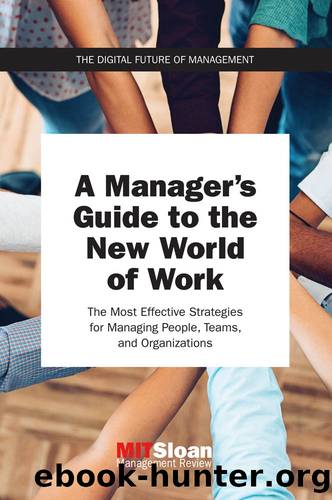A Manager's Guide to the New World of Work by MIT Sloan Management Review

Author:MIT Sloan Management Review
Language: eng
Format: epub
Publisher: MIT Press
Connectivity: What We Gain, What We Lose
When we solve problems collaboratively—whether we’re making strategic decisions, fixing operational glitches, or generating ideas—we engage in two categories of actions: (1) gathering the facts we need to generate and develop various potential solutions, and (2) figuring out the best solutions.
Academics are not strangers to the study of problem solving. There is a large body of research about it, with contexts including recreational venues like adventure racing4 and escape rooms,5 simulated laboratory experiments, and real-world field research in the workplace. But most of the research has focused on individual rather than collective problem solving.6 Even among studies of collaboration, few have looked into how much we want to have.7
So we headed to the laboratory to explore that question. In our first study,8 we randomly assigned individuals to 51 16-person organizations—some more connected by technology than others—and asked each organization to solve a complex problem: Divine the who, what, where, and when of an impending terrorist attack (akin to the famous Clue whodunit game but with higher hypothetical stakes). Each organization used a platform not unlike the collaborative tools used in workplaces today: Through their computers, individuals could search for information, share it with one another, and contribute theories about solutions while the platform tracked all behavior.
We found that connectivity had different effects on the fact-finding and figuring stages of problem solving. For finding facts, more connectivity was better, without limitation. But figuring out what to do with those facts—actually creating the solutions—was undermined by too much connectedness. The same connections that helped individuals collaborate in their search for information also encouraged them to reach consensus on less-than-perfect solutions, making connectivity a true double-edged sword.
Fact-finding and figuring are, we believe, representative of broader classes of activities. If we were to describe this trade-off more generically, it is the question of whether the task primarily requires coordination or imagination. If there are acute coordination needs (for instance, avoiding redundant effort by ensuring we don’t all look under the same pillow for the keys), then always-on connectivity is helpful. If imagination is more critical, then always-on connectivity can make it nearly impossible to manage the creativity of multiple minds, which requires a balance between allowing those minds to learn from one another and enhancing the capacity of each one to generate fresh ideas. Too little communication, and there’s no learning and no synergy. Too much communication, and all the minds end up in the same place, focusing on the same types of solutions.
Download
This site does not store any files on its server. We only index and link to content provided by other sites. Please contact the content providers to delete copyright contents if any and email us, we'll remove relevant links or contents immediately.
Hit Refresh by Satya Nadella(8328)
The Compound Effect by Darren Hardy(7545)
Change Your Questions, Change Your Life by Marilee Adams(6635)
Nudge - Improving Decisions about Health, Wealth, and Happiness by Thaler Sunstein(6629)
The Black Swan by Nassim Nicholas Taleb(6182)
Daring Greatly by Brene Brown(5636)
Deep Work by Cal Newport(5452)
Principles: Life and Work by Ray Dalio(5315)
Rich Dad Poor Dad by Robert T. Kiyosaki(5140)
The Myth of the Strong Leader by Archie Brown(4785)
Man-made Catastrophes and Risk Information Concealment by Dmitry Chernov & Didier Sornette(4728)
Big Magic: Creative Living Beyond Fear by Elizabeth Gilbert(4717)
The Slight Edge by Jeff Olson(4716)
Discipline Equals Freedom by Jocko Willink(4629)
The Motivation Myth by Jeff Haden(4521)
Digital Minimalism by Cal Newport;(4509)
Stone's Rules by Roger Stone(4412)
Management Strategies for the Cloud Revolution: How Cloud Computing Is Transforming Business and Why You Can't Afford to Be Left Behind by Charles Babcock(4127)
The Doodle Revolution by Sunni Brown(4034)
